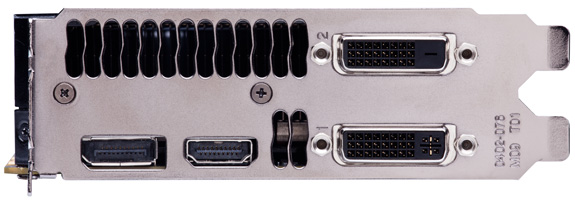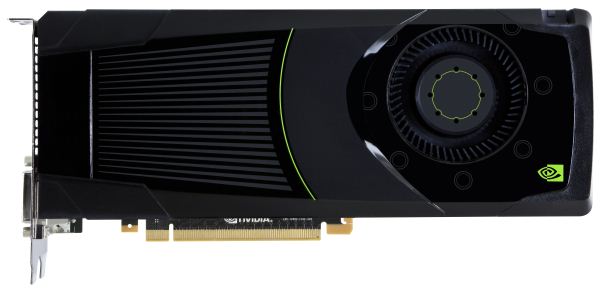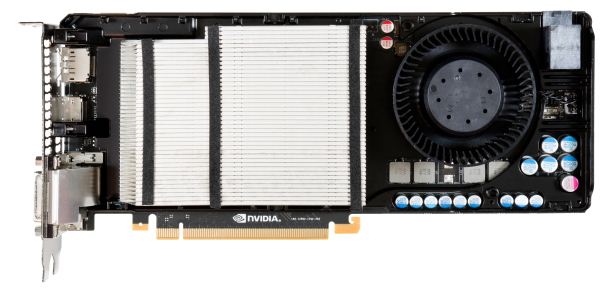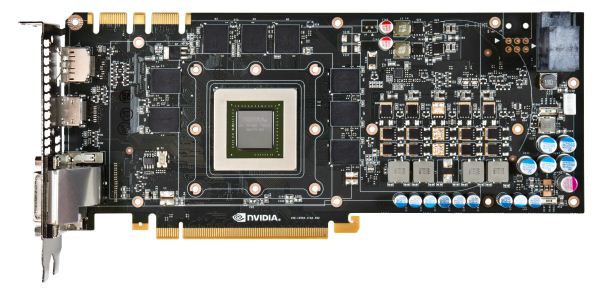NVIDIA GeForce GTX 680 Review: Retaking The Performance Crown
by Ryan Smith on March 22, 2012 9:00 AM ESTMeet the GeForce GTX 680
All things considered the design of the GeForce GTX 680 is not a radical departure from the GTX 580, but at the same time it also has some distinct differences owing to the fact that its TDP is some 50W lower than GTX 580.
Like the past GTX x80 cards, the basic design of the GTX 680 is that of a blower. A radial fan at the rear of the card sucks in air and pushes it towards the front of the card. Notably, due to a combination of card length and the fan position, the “wedge” around the fan has been done away with. NVIDIA tells us that this shouldn’t significantly impact the cooling of the card, particularly since it has a lower TDP in the first place, but when used in SLI it will remove some of the breathing room than the GTX 580 enjoyed.
Looking at the fan itself, compared to the GTX 580 the fan has been moved from the center of the card to the top of the card. This is due to NVIDIA’s port configuration, which uses a stacked DVI connector that consumes what would have normally been part of the exhaust vent on the GTX 580. We’ll get into the port configuration more in a minute, but for the moment the significance is that because the GTX 680 only has half a vent NVIDIA has moved the fan to match the vent, which is why the fan has been moved up.
On that note, the repositioning of the fan also had its own ramifications. Because the fan is now so close to the top and at the same time so close to the rear, NVIDIA went with a unique method of arranging the PCIe power sockets. Rather than having them side-by-side as we’ve seen on countless NVIDIA cards in the past, the sockets are stacked on each other in a staggered configuration. With the fan otherwise occupying the space that one of the sockets would take up, this configuration allowed NVIDIA to have two sockets without lengthening the card just to fit another socket. Overall this staggered design is not too difficult to work with, though with one socket facing the opposite way it might require some cable repositioning if you have a well maintained cable run.
Moving on, when we remove the shroud on the GTX 680 we see the fan, baseplate, and heatsink in full detail. NVIDIA is using an aluminum fin stacked heatsink, very similar to what we saw on the GTX 580. Underneath the heatsink NVIDIA is using a set of three heatpipes to transfer heat between the GPU and the heatsink. This is as opposed to the vapor chamber on the GTX 580, and while this setup doesn’t allow empirical testing, given the high efficiency of vapor chambers it’s likely that this isn’t quite as efficient, though to what degree we couldn’t say.
Finally, after removing the fan, baseplate, and heatsink, we can see the PCB in full detail. Unlike GF110 and GF114, GK104 is not capped with an IHS, allowing for the heatsink to directly come in contact with the GPU die. Meanwhile arranged around the GPU we can see the 8 2Gb GDDR5 RAM modules that give the GTX 680 its 2GB of RAM. These are Hynix R0C modules, which means they’re rated for 6GHz, the stock memory speed for the GTX 680. Overall the card measures 10” long with no overhang from the shroud, making it 0.5” shorter than the GTX 580.
Looking at the top of the card, as always we see the SLI connectors. Following in the footsteps of the GTX 580, the GTX 680 features 2 SLI connectors, allowing for up to 3-way SLI.
Meanwhile at the front of the card we see the I/O bracket. As we alluded to previously, the GTX 680 uses a stacked DVI design here; NVIDIA has done everything they can to keep the DVI ports at the very bottom of the card to avoid impeding airflow, but the upper DVI port still occupies roughly 40% of what would otherwise be the vent. Altogether the GTX 680 features 2 DL-DVI ports, a full size HDMI port, and a full size DisplayPort.

While NVIDIA has used DVI and HDMI ports for quite some time, this is the first time NVIDIA has included DIsplayPort on a reference design. Unfortunately we find that this ruffles our feathers a bit, although this isn’t strictly NVIDIA’s fault. As we’ve covered in the past, DisplayPort comes in both a full size and miniDP configuration – AMD in particular has used miniDP since the Radeon HD 6800 series in 2010. And while we’re happy to see DisplayPort finally make it into an NVIDIA reference design, the fact that it’s a full size DisplayPort is less than encouraging because at this point in time DisplayPort has largely been replaced by miniDP.
Ultimately the fault for this lies more with the VESA than NVIDIA, but it’s indicative of a larger problem in the DisplayPort community in that both full size DP and miniDP are equally valid and equally capable ports. While full size DisplayPort has the distinction of coming first, thanks in large part to Apple it has largely been displaced by miniDP as the most common variant on source devices. The problem with this is that both miniDP and DisplayPort are now in wide use; wide, redundant use.
At this point desktop computers and video cards coming with full size DisplayPorts is silly at best, and frustrating at worst. The laptop guys aren’t going to give up miniDP due to the space savings, and there’s no significantly good reason to use DisplayPort on desktops when miniDP offers the same functionality. We would rather see the PC industry standardize on miniDP across all source devices, and thereby eliminate any ambiguity with regards to what cables or adaptors are necessary. DisplayPort adoption has been slow enough – having 2 variants of the port on source devices only makes it more confusing for everyone.
Finally, while we’re on the subject of display connectivity we quickly took a look at how the idle clockspeeds of GTX 680 are impacted by the use of multiple displays. With 2 displays GTX 680 can utilize its full idle clocks, but only if both displays are connected via a TMDS type connection (DVI/HDMI) and run with identical timings. But if different timings are used or if one display is connected via DisplayPort, then the GTX 680 will shift to its low power 3D clocks. However if we expand that to 3 monitors and enable NVIDIA Surround, then the GTX 680 can operate at full idle regardless of whether DisplayPort is used or not.













404 Comments
View All Comments
CeriseCogburn - Sunday, March 25, 2012 - link
They get to show amd "catching up" so they like it. They get to try to puke out Kepler's 2G ram and make amd's 3G shine, so they "can't resist" - and when frame rates fall below playable, "they all of a sudden" "don't care", even when the puking attempt fails. They haven't been able to resist since the 580 w 1.5G vs 2G 6950/6970 it was a great blame the low ram game for any changes.Then they checked 6950 1G 2G and 2G was slower...but so what.
Now 2G Kepler has put the ram lie to rest even in triple monitor gaming... but any lesser win or loss or slimming margin can still be blamed on that, it gets people "buying the amd card" and they get real frustrated here when they can't figure out why Nvidia is winning when they don't believe it should be. It's always expressed in the article how shocked they are. So ram is a convenient scapegoat. It's always used a "future proofing" notion as well, though no evidence has ever surfaced for that.
_vor_ - Sunday, March 25, 2012 - link
What's with all the nerdrage? Do you work for NVIDIA?formulav8 - Sunday, March 25, 2012 - link
Get over yourself already. NVidia doesn't even like You. Can't believe how people feel about a stinking stupid corporation.CeriseCogburn - Tuesday, March 27, 2012 - link
It's not about a corporation it's about facts guy. Facts mean my friends and my readers get the best they can get for the buck they are paying.Just because amd is behind and therefore lies are told, does not mean the truth should not shine through !
The truth shall shine through !
AnnonymousCoward - Sunday, March 25, 2012 - link
Personally, I don't care if the card has 64kB of RAM. Or 8 million stream processors. Performance, cost, power, and noise are what matter.And back to my point: performance in the 20-50fps range at 2560x1600 4xAA is meaningless and not a criteria for judgment.
CeriseCogburn - Tuesday, March 27, 2012 - link
I never disagreed with that point I merely explained why things are done in such and such a way while ignoring other things.It's not difficult at all.
Zephyr66z0r - Sunday, March 25, 2012 - link
Well I understand 'some' of the tech behind the GTX680 one thing stands out. 256bit bus width, when you see that with nvidia its along the lines of GTX560.... so does that mean there's going be a 384bit (mid-high) or 512bit(high-enth, 256bit + 256bit + 2 GPU) card/s coming out?I can't wait, anyone done SLi with it yet?
dmnwlv - Sunday, March 25, 2012 - link
First off, I think nVidia has done a good job with the new GTX680.However I do not need a game that is already running at 100+ frames to be even faster.
It needs to be fast at where it counts - games that are still running slow at 60 fps and below.
For this, of 3 relevant games, nVidia is faster at just one of them. Experience (if you also remember) has shown that the results could be very different once frames for some settings/games hit below 60fps.
Hence I cannot agree with all the big f about GTX680 is so much faster fuss.
You guys are led by the heart (much alike ati fanboys you used to call) than the brain.
And all other compute tests are non-relevant to me (and majority of you to be honest).
gramboh - Monday, March 26, 2012 - link
What about a little game (that several million people play) called Battlefield 3? NV has a massive lead with the GTX 680 over the 7970/7950. AT only benches single player, but the game is even more punishing in 64 player multiplayer. Having a smooth framerate at max detail with 4X AA/16X AF is a big competitive advantage and makes the game significantly more enjoyable.Kind of disappointed the card isn't faster in Witcher 2, which I think has the best graphics of a single player game.
CeriseCogburn - Tuesday, March 27, 2012 - link
Have all of you people repeating that FUD forgotten Shogun 2 Total War ?It's the hardest game in the bench set according to anandtech...
How is it that THE HARDEST GAME that Nvidia swept top to bottom at every resolution is suddenly and completely forgotten about, while we hear these other FUD declarations ?
How does that work, just repeat what some other mistaken fudder spewed ?